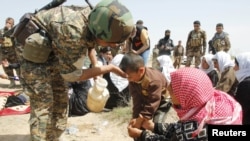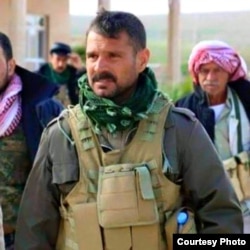When Islamic State militants overran the Sinjar region in northern Iraq in August 2014, they captured and massacred thousands of members of the Yazidi minority, ethnic Kurds whose ancient religion is derived from Zoroastrianism, and forced over 200,000 to flee their villages.
In response to IS atrocities which the United Nations says could amount to genocide, Yazidis formed their own militias that are now fighting against IS in the Sinjar region.
But these militias have inflamed Kurdish political rivalries, deepening existing fault lines between groups in northern Iraq's semiautonomous Kurdish region.
Meet The Militias
Hayri Demir, editor in chief of Ezidi Press, told RFE/RL that there are three de facto Yazidi militia groups fighting against IS in the Kurdish region of northern Iraq.
The Sinjar Resistance Units (YBŞ), an offshoot of the pan-Kurdish Kurdistan Workers Party (PKK), have been trained by the Syrian Kurdish People's Protection Units or YPG. Like the YPG, which is known for its women militia fighters, the Yazidi group also has an all-female unit, the YPJ-Sinjar.
The YBS has around 1,200 fighters, according to Demir. But Hassan, a Yazidi man in his twenties who fights alongside the militia, says that the YBS's ranks have now swelled to about 2,000 men and women.
"The numbers are increasing; every day, more young men and women are joining the YBS," Hassan told RFE/RL's Radio Free Iraq.
And more Yazidi YBS fighters are being trained by the Kurdish YPG in Syria's Hassakah Province, says Sarhad Shingali, a leading YBS fighter.
Among the YBS fighters are a number of Yazidi women who escaped after being abducted by IS gunmen, Shingali told Radio Free Iraq's correspondent in Irbil.
Unlike the Kurdish militias, the Yazidi YBS has not attracted foreign fighters from the United States, Canada, Australia, and Europe.
But Yazidis living in Europe have joined, Shingali claims, though he did not say how many have done so.
While the Kurdish militias have attracted non-Kurdish foreign fighters, including from the United States and Europe, the Yazidi YBS has no non-Yazidi fighters in its ranks. Shingali claims ethnic Yazidis living in Europe have joined, however.
The second and largest Yazidi militia group, the Sinjar Defense Units (HPS), is led by a top Yazidi military commander, Haider Shesho. It numbers around 5,000 fighters, including about 400 women, its members say. Shesho is also a nonactive member of the Patriotic Union of Kurdistan (PUK) political party, according to Wladimir van Wilgenburg, an expert on Kurdish politics with the U.S.-based Jamestown Foundation.
Meanwhile, Haider Shesho's relative Qasim Shesho leads a third group of Yazidi militia, operating under the auspices of the Kurdish Peshmerga around the Sherefedin shrine, which IS tried to burn down.
"We decided IS would have to walk on our dead body if they wanted to desecrate Sherefedin," Qasim Shesho told VICE news earlier this year.
Kurdish Rivalries
Some Yazidis have blamed the Peshmerga for the atrocities IS militants carried out against them. They say that the official Iraqi Kurdish militia failed to put up a fight and had even abandoned the Yazidis to their fate on August 3, 2014, when IS invaded Sinjar.
The Peshmerga's resounding defeat at the hands of IS and the extremists' subsequent atrocities against the Yazidi people meant that the Yazidis had to take up arms to defend themselves, those who created the militias say.
"We have no choice other than the formation of this force," YBS militiaman Shingali says. "We have no alternative...we have to save our people from IS and terrorist attacks."
But the fact that it is the Yazidis and PKK fighters who are doing most of the fighting against IS in Sinjar has inflamed inter-Kurdish political rivalries and caused difficulties with the Kurdistan Regional Government, or KRG.
The KRG fears that if and when IS is defeated, armed Yazidi groups will fight the Kurds for more local power.
"Sinjar is a political powder keg," says Ezidi Press's Demir. "Because most Yazidis have no confidence in the Peshmerga after August 3 (when IS overran Sinjar), about 6,000 of the Peshmerga forces stationed in Sinjar are Yazidis."
Peshmerga Or Bust
These fears have led the president of Iraq's Kurdish region, Masud Barzani, to take steps to crack down on Yazidi militias and push them to fight under the authority of his Peshmerga Ministry.
In April, KRG forces arrested HPS commander Haider Shesho, accusing him of trying to "create an illegitimate militia group" and of trying to challenge KRG authorities around Sinjar.
Shesho was also accused of having ties with the Iran-backed Shi'ite Popular Mobilization units that are fighting alongside Iraqi forces against IS.
Following Shesho's arrest, Barzani said he was not willing to tolerate resistance units that did not fight under the Peshmerga Ministry and that Shesho's HPS militia would have to also renounce its flag.
After Shesho's release on April 13, the Yazidi commander said that his militia would "embrace the help of the Peshmerga Ministry and all other Kurdish authorities" but that HPS fighters were "free to subordinate to the Peshmerga Ministry or stay independent."
While there have been some moves to place the HPS under the Peshmerga, this does not seem to have fully happened.
"After the arrest and subsequent release of Mr. Shesho, the KRG's Peshmerga Ministry agreed to take in fighters, but the fact is that they have not yet been administratively designated as Peshmerga forces," HPS deputy leader Dawood Jundi told Radio Free Iraq. "They were given some financial support for one month but they have not yet been properly equipped."
HPS militiamen who do not agree to fight under the authority of the Peshmerga Ministry will not receive a salary, Demir of Ezidi Press told RFE/RL.
Demir said that according to HPS leader Shesho, the militia fought on a budget of $60,000 for a budget of $60,000 from August through December 2014.
Not Enough Weapons
Yazidi militia members say that one of the side effects of the KRG's fears that Yazidis will demand greater power has been that even those who are fighting under the auspices of the Peshmerga have not been given enough weapons.
Qasim Shesho, who commands around 3,000 Yazidi Peshmerga fighters, told the German website Taz.de in May that his group would continue fighting until IS was defeated.
"But we only get enough weapons to defend ourselves and not to carry out our own offensives," Qasim said.
One of Qasim's sons said that the reason the KRG had not supplied the Yazidis with weapons was because "they fear we are too strong and will build an independent army."
Revenge?
Qasim Shesho told Taz.de that he would not allow reprisal attacks against Arabs, whom some Yazidis blame for complicity in IS atrocities.
But there have been reports that some Yazidi militiamen have carried out revenge attacks against Sunnis in response to IS crimes.
A June 9 report by Amnesty International found that members of a Yazidi militia attacked two Arab villages, Jiri and Sibaya in the Sinjar region on January 25, 2015. The militia is thought to have killed 21 people, half of them elderly women and men and children and injured several others.
"It was an act of revenge by the Yazidis," 41-year-old Dhafer Ali Hussein from Sibaya, one of the affected villages, told Reuters in February. "The aim is to expel Arabs from the area so that only Yazidis remain. They want to change the map."



